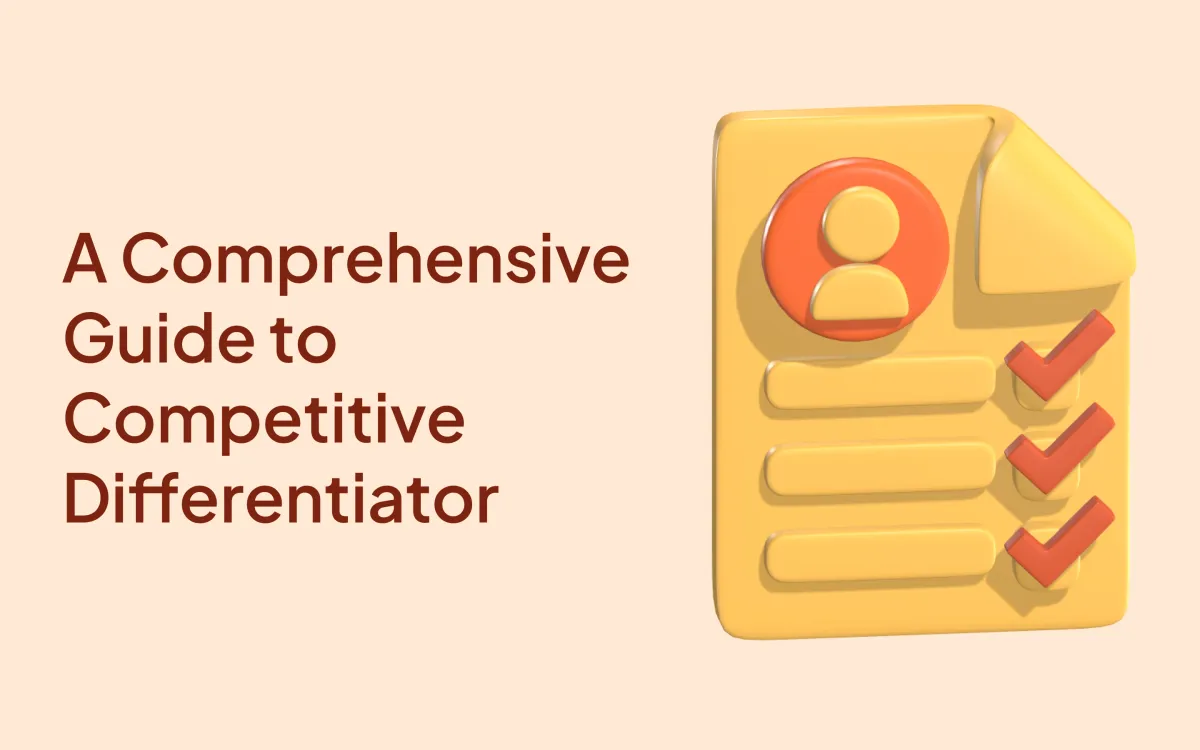A Comprehensive Guide to Competitive Differentiator
Learn how to stand out from competitors with our comprehensive guide to competitive differentiators and create a unique advantage in your market.

Have you ever wondered what makes one company stand out from another, even when they offer similar products or services?
In today’s fast-paced market, where customers have countless options at their fingertips, standing out is more important than ever. This is where competitive differentiation comes into play.
Competitive differentiation is all about identifying and highlighting what makes your business unique compared to others in the same industry. It's the key to capturing attention, building customer loyalty, and ultimately, driving success. Without clear differentiation, businesses risk blending in with the competition, making it harder to attract and retain customers.
In this article, we'll explore why competitive differentiation is essential for any business looking to thrive in a crowded marketplace.
Definition of Competitive Differentiation: What It Is and Why It Matters
At its core, a competitive differentiator is anything that makes your business stand out from the competition. It’s the unique aspects of your product, service, or brand that give customers a reason to choose you over others. This could be anything from offering better quality, having a more affordable price, providing exceptional customer service, or even having a brand that people feel emotionally connected to.
But why is this important? In today’s crowded marketplace, there are often many companies offering similar products or services. Without a clear competitive differentiator, your business might just blend in with the rest, making it difficult for customers to see why they should choose you.
Competitive differentiation is important because it helps your business not only attract customers but also keep them coming back. When you clearly communicate what makes you different and better, customers are more likely to remember you and become loyal supporters.
Important Key Competitive Differentiators

a. Unique Value Proposition
A Unique Value Proposition, or UVP, is a clear statement that explains why your product or service is different from and better than the competition. It's what makes your business special and tells customers why they should choose you over anyone else. A strong UVP is essential because it directly communicates the unique benefits your business offers and how those benefits solve a problem or fulfill a need that customers have.
A strong UVP sets your business apart by making it crystal clear what you offer that no one else does. It helps customers quickly understand why they should care about your product and why it’s worth their time and money. Without a compelling UVP, your business might get lost in the noise of the market, with potential customers passing you by for something they see as more distinctive or valuable.
Examples of Effective UVP in the Market
Domino's Pizza: "You get fresh, hot pizza delivered to your door in 30 minutes or less—or it's free." This UVP worked wonders for Domino’s because it addressed a specific customer need: fast, reliable delivery. Customers knew exactly what to expect, and this promise set Domino’s apart from other pizza chains.
b. Customer Experience
Customer experience refers to the overall feeling a customer has when interacting with your business, from the moment they first hear about you to the after-sales service they receive. It’s more than just providing good customer service; it’s about creating a positive, memorable journey for the customer at every touchpoint.
The Impact of Customer Experience on Brand Loyalty and Differentiation

Think about your favorite brand. What makes you keep coming back? Often, it’s not just the product itself, but how the brand makes you feel as a customer. A great customer experience can turn first-time buyers into loyal customers who choose your brand time and time again. When customers have a positive experience, they are more likely to recommend your business to others, which can help you grow.
Customer experience is also a powerful differentiator. In markets where products and services are similar, the way you treat your customers can be the key factor that sets you apart from competitors. If customers know they can rely on your business for a consistently great experience, they’re more likely to stick with you, even if other options are available.
C. Product Quality
Product quality is all about how well your product meets the expectations of your customers. High-quality products are reliable, durable, and perform as promised. Maintaining high product quality is crucial because it directly impacts customer satisfaction, brand reputation, and your ability to stand out in a crowded market.
Case Studies of Companies That Lead with Product Quality
Apple:
Apple is renowned for its high product quality, particularly in its iPhones, MacBooks, and other devices. Apple products are known for their sleek design, durability, and seamless user experience. By focusing on quality, Apple has built a loyal customer base willing to pay higher prices for its products. This commitment to quality has helped Apple maintain its position as a leader in the technology industry.
D. Innovation
Innovation is all about coming up with new ideas, products, or ways of doing things that provide better solutions for your customers. In business, continuous innovation is essential because it helps you stay ahead of the competition by offering something fresh and valuable that others don’t.
How Continuous Innovation Drives Differentiation
In today’s fast-paced world, customer needs and market conditions are constantly changing. What worked yesterday might not work tomorrow. That’s why businesses need to keep innovating to remain relevant and competitive. When you continuously innovate, you’re able to offer new features, improved products, or entirely new services that meet the evolving needs of your customers. This not only keeps your current customers satisfied but also attracts new ones.
The Balance Between Innovation and Practicality
While innovation is important, it’s equally important to strike a balance between being innovative and being practical. Not every new idea will be successful, and not every innovation will resonate with your customers. Sometimes, businesses can get caught up in trying to be overly innovative, introducing features or products that are too complex, too expensive, or simply not useful for customers.
E. Brand Reputation
Brand reputation is how people perceive your company and its products or services. It’s the overall impression that your brand leaves in the minds of customers, and it plays a crucial role in your business’s success. A strong brand reputation can make customers more likely to choose your business over others, even if your prices are higher or your products are similar to competitors.
Building and Leveraging a Strong Brand Reputation

Building a strong brand reputation doesn’t happen overnight; it’s the result of consistent effort over time. To build a positive reputation, your business needs to consistently deliver on its promises, provide high-quality products or services, and treat customers with respect and care. This means ensuring that every interaction a customer has with your brand, whether online or in person, is a positive one.
Trust is a key component of brand reputation. When customers trust your brand, they are more likely to remain loyal, recommend your products to others, and give you the benefit of the doubt if something goes wrong. You can build trust by being transparent, keeping your promises, and responding quickly and fairly to customer concerns.
F. Pricing Strategy
Pricing plays an important role in how customers perceive your brand. It’s one of the first things they notice, and it influences their buying decisions. A well-thought-out pricing strategy can help differentiate your business by aligning with the unique value you provide.
For example, if your products are priced higher than those of your competitors, it can signal that your products are of higher quality or offer more value. On the other hand, if your prices are lower, it might attract cost-conscious customers who are looking for a good deal. Either way, your pricing helps position your brand in the market and can make it more attractive to a specific group of customers.
Having a clear pricing strategy can also help you stand out in a crowded market. When customers understand why your price monitorings are set the way they are—whether it’s because of premium quality, added benefits, or cost savings—they are more likely to choose your brand because they see the value in what you’re offering.
G. Customer Support
Customer support is all about helping your customers when they have questions, problems, or need assistance with your products or services. Exceptional customer support isn’t just about solving problems—it’s about creating a positive experience that makes customers feel valued and cared for. When done right, customer support can be a powerful way to set your business apart from the competition.
Think about it this way: even if a product is great, if the customer service is poor, customers may feel frustrated and undervalued. On the other hand, if a company provides outstanding support—responding quickly, being friendly and helpful, and going the extra mile—customers are likely to remember that positive experience and choose to stay loyal to the brand.
H. Speed to Market
Speed to market refers to how quickly a company can develop a product or service and make it available to customers. In today’s fast-paced world, being the first to offer something new can give your business a significant edge over the competition. However, while speed is important, it’s equally important to ensure that what you’re offering is of high quality.
I. Sustainability
Sustainability refers to practices that meet the needs of the present without compromising the ability of future generations to meet their own needs. In business, it means operating in a way that is environmentally friendly, socially responsible, and economically viable. As more consumers become concerned about the impact of their purchases on the planet, sustainability is becoming a critical factor in how they choose which brands to support.
How to Integrate Sustainability Into Your Business

- Assess Your Impact:
Understand your environmental footprint by analyzing your use of materials, energy, and waste.
- Choose Sustainable Materials:
Opt for renewable, recyclable, or biodegradable materials to reduce your reliance on non-renewable resources.
- Reduce Waste:
Minimize waste in production and packaging, and consider offering recycling programs for your products.
- Conserve Energy:
Implement energy-saving practices, such as using energy-efficient equipment or renewable energy sources.
- Promote Ethical Practices:
Ensure fair labor practices in your business and with your suppliers.
- Engage Customers:
Educate your customers about your sustainability efforts and encourage them to make eco-friendly choices.
- Set Clear Goals:
Establish measurable sustainability goals and track your progress to stay accountable.
- Partner with Sustainable Organizations:
Collaborate with environmental groups or join sustainability initiatives to amplify your efforts.
- Communicate Transparently:
Share your sustainability efforts with customers and stakeholders to build trust and demonstrate commitment.
J. Network and Partnerships
Strategic partnerships are collaborations with other businesses that can help you stand out from the competition. By teaming up with complementary companies, you can offer more value to your customers, access new markets, and share resources, which can set your business apart.
Partnering with the right businesses allows you to combine strengths and offer something unique. For example, a tech company might partner with a leading software provider to enhance its product offerings. These collaborations can help you deliver better products or services than competitors who don’t have similar partnerships.
How to Identify and Implement Your Competitive Differentiators

Identifying and effectively using your competitive differentiators is key to standing out in the market. Your differentiators are the unique aspects of your business that make customers choose you over others. Here’s how to find and use them to your advantage.
Steps to Identify Your Unique Differentiators
- Understand Your Customers:
Start by getting to know your customers’ needs, preferences, and pain points. What are they looking for in a product or service? What problems do they need solved? Understanding this helps you identify what makes your offering valuable to them.
- Analyze Your Competitors:
Look at what your competitors are offering and how they position themselves in the market. What are their strengths and weaknesses? Identifying gaps in their offerings can help you find areas where you can stand out.
- Evaluate Your Strengths:
Consider what your business does exceptionally well. Do you offer superior customer service, innovative technology, or higher-quality products? These strengths can serve as your differentiators.
- Gather Feedback:
Talk to your customers and team members to get their input on what makes your business unique. Often, those who interact with your products or services daily can provide valuable insights into what sets you apart.
- Test and Refine:
Once you’ve identified potential differentiators, test them in the market. See how customers respond and be willing to refine your approach based on their feedback.
Best Practices for Implementing and Communicating Your Competitive Differentiators

Incorporate Differentiators Into Your Brand
Make your differentiators a core part of your brand identity. This means reflecting them in your messaging, marketing materials, and overall customer experience.
Communicate Clearly
Ensure that your customers understand what makes you different. Use simple, clear language to highlight your unique benefits across all touchpoints, from your website to your social media channels.
Train Your Team
Make sure your employees are well-versed in your differentiators so they can communicate them effectively to customers. When everyone on your team understands what sets your business apart, it strengthens your overall brand message.
Consistently Deliver on Your Promises
Your differentiators will only be effective if you consistently deliver on them. If you claim to offer the best customer service, for example, ensure that every interaction meets that standard. Consistency builds trust and reinforces your brand’s unique position.
Monitor and Adapt
The market is always changing, so it’s important to regularly review your differentiators and adapt as needed. Stay tuned to customer feedback and market trends to ensure that your unique advantages remain relevant and compelling.
In summary, identifying your competitive differentiators involves understanding your customers, analyzing competitors, and evaluating your strengths. Once identified, you need to integrate these differentiators into your brand, communicate them clearly, and consistently deliver on them to effectively stand out in the market.
Conclusion
To succeed in a crowded market, it's essential to identify and leverage what makes your business unique. Whether it's your product quality, customer service, or innovative approach, these differentiators attract customers and set you apart from competitors.
By consistently delivering on your strengths and staying adaptable, you can build a loyal customer base and maintain a strong market position. In short, being different in ways that matter to your customers is the key to thriving in any competitive environment.
Frequently Asked Questions
1. What is an example of a competitive differentiator?
A competitive differentiator is something that makes your business stand out from competitors. For example, offering faster shipping or better customer service can be a key differentiator that attracts customers to your brand.
2. What is a comparative differentiator?
A comparative differentiator highlights how your product or service is better when compared to others. It directly shows why your offering is more valuable, such as having higher quality materials or a lower price than competitors.
3. What is an example of competitive strategy differentiation?
An example of competitive strategy differentiation is Apple focusing on sleek design and user-friendly technology to set its products apart from other tech companies. This strategy helps them stand out and attract loyal customers.
4. How to do competitive differentiation?
To achieve competitive differentiation, first understand what your competitors offer and what your customers value most. Then, identify ways to provide something better or unique, like higher quality, exceptional service, or exclusive features. Focus on these strengths in your marketing and product development to stand out from the competition.
